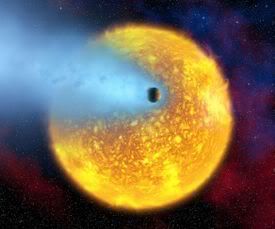The AbstractScience wrote:If life on Earth did indeed spring forth within our vast oceans, then it also might be teeming on thousands of other worlds. New models suggest that as many as one-third of the solar systems in the galactic neighborhood might contain terrestrial planets with oceans of water that could harbor life.
The new findings counter previous hypotheses on planetary formation, which have claimed that few solar systems contain Earth-like worlds. Part of the problem has to do with so-called hot Jupiters. These gas giants, which orbit closer to their parent stars than Mercury does to the sun, form relatively quickly from the gas in the protoplanetary disk. Astronomers assumed that as these hot Jupiters plow through disk material, they "vacuum up" a lot of the dust and rock or eject it from the solar system. That would leave little material left with which to make water-logged planets.
But "the new models indicate these early ideas were probably wrong," says planetary scientist Sean Raymond of the University of Colorado, Boulder. Reporting in today's issue of Science, Raymond and colleagues say they ran simulations lasting more than 8 months each on more than a dozen desktop computers. They observed how nascent solar systems evolved over about 200 million years, basing the initial conditions on current theories of how planets formed in our own solar system. The researchers found that when gas giants migrate, they fling lots of rocky debris away from the star and into the habitable zone, where liquid water can exist on a planet's surface. There, the debris frequently coalesces into Earth-sized planets.
This kind of early evolution also perturbs the disk, causing comets outlying billions of kilometers away to dive toward the star. Enough of these ice balls hit the terrestrial planets to deliver large quantities of water. "We were very surprised to learn that these planets are water-rich and probably covered in global oceans," he says.
The findings suggest that thousands of planetary systems within the Milky Way could harbor Earth-like planets, says Rory Barnes, a planetary scientist at the University of Arizona in Tucson. Still, he cautions that the key question is how many planetary systems have hot Jupiters. The current figures could be an overestimate: Existing exoplanet detection methods are "strongly biased toward" this type of planet, he says, but "strongly biased against" finding solar systems like our own, in which gas giants settle farther away from their parent star.
NASA pdf actually showing a few examples of the simulated star systems with Earthlike planets and 'Hot Jupiters'.




